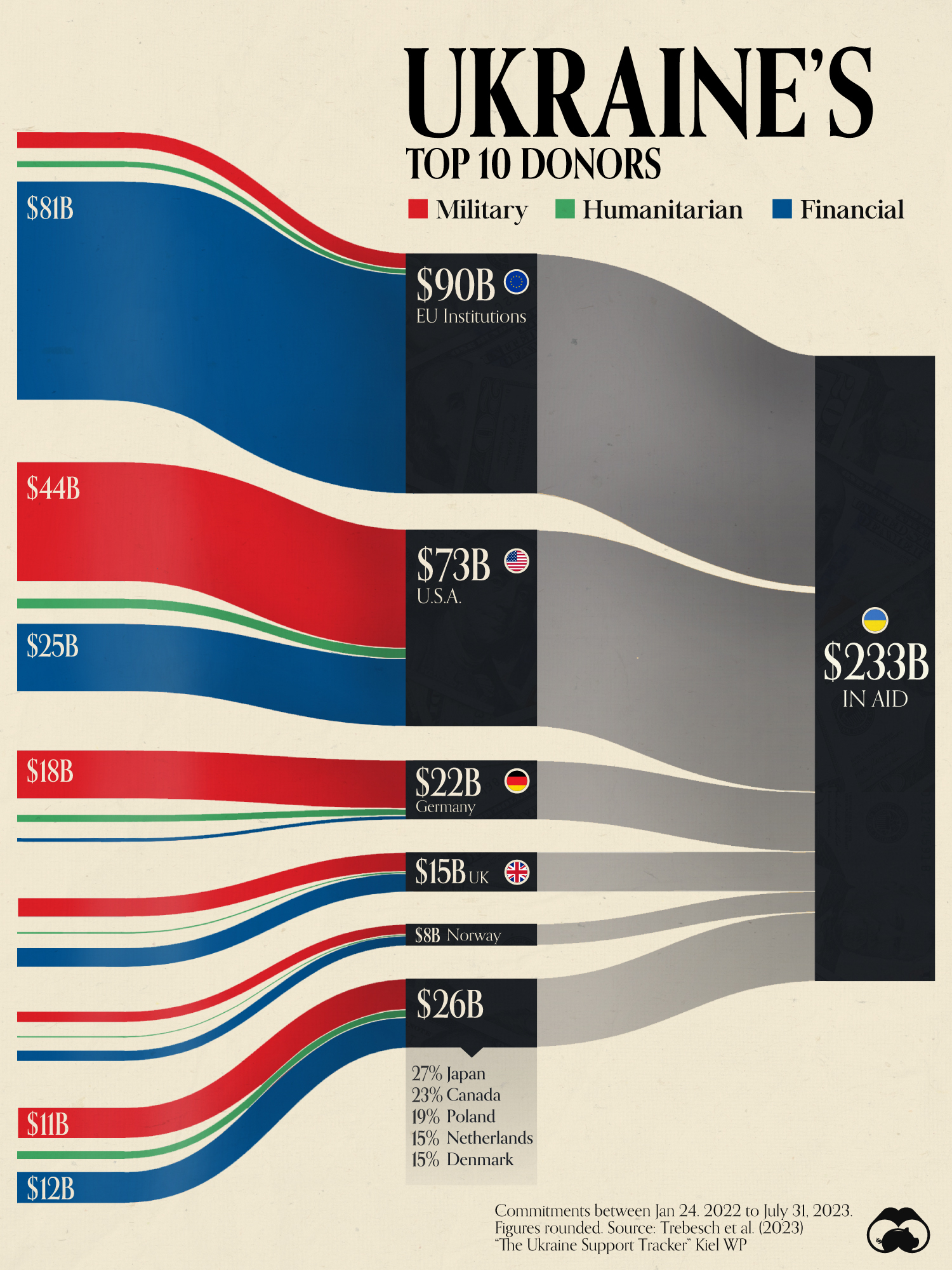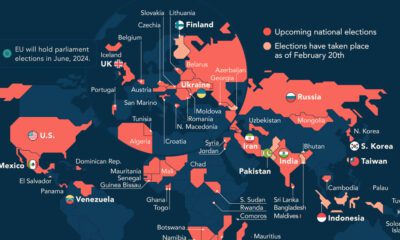Politics
Visualizing $233B in Ukraine Aid

The Top 10 Donors to Ukraine
Ukraine has received over $230 billion in aid since the Russian invasion in 2022.
EU institutions and the U.S. together account for almost 70% of the total aid.
This graphic uses data from the Ukraine Support Tracker to visualize the top 10 donors to Ukraine between Jan 24, 2022, and July 31, 2023.
European Union is the Biggest Donor
Military aid to Ukraine includes weapons, equipment, and items explicitly donated to the Ukrainian army.
The graphic also illustrates humanitarian aid to assist civilians and financial aid like grants, loans, and guarantees made to the Ukrainian government. It does not include private donations, support for refugees outside of Ukraine, or assistance from international organizations.
As of July 2023, the European Union institutions have been the biggest donor, sending over $90 billion through various mechanisms such as loans or grants, and military assistance through its European Peace Facility fund.
Unlike the United States, which has the largest share of aid in military support, the EU has focused on financial aid.
| Donor | Military (Billion USD) | Humanitarian | Financial | Total |
|---|---|---|---|---|
| 🇪🇺 EU Institutions | 5.9 | 2.2 | 81.4 | 89.5 |
| 🇺🇸 U.S. | 44.4 | 3.7 | 25.1 | 73.2 |
| 🇩🇪 Germany | 18.0 | 2.6 | 1.4 | 22.1 |
| 🇬🇧 UK | 7.0 | 0.6 | 7.0 | 14.6 |
| 🇳🇴 Norway | 3.9 | 0.2 | 3.8 | 7.9 |
| 🇯🇵 Japan | 0.0 | 1.0 | 5.8 | 6.8 |
| 🇨🇦 Canada | 1.8 | 0.4 | 3.6 | 5.8 |
| 🇵🇱 Poland | 3.2 | 0.4 | 0.9 | 4.5 |
| 🇳🇱 Netherlands | 2.6 | 0.6 | 1.1 | 4.3 |
| 🇩🇰 Denmark | 3.7 | 0.3 | 0.1 | 4.1 |
| Total | 90.5 | 12.2 | 130.1 | 232.9 |
EU aid includes $3.3 billion for lethal equipment and an additional $2.1 billion to supply Ukraine with one million rounds of ammunition.
The bloc is considering providing up to $53 billion in financial assistance to Ukraine (in loans and grants) for the 2023-2027 period, including using frozen Russian assets to support Ukraine’s reconstruction.
While not captured in this dataset, Denmark and the Netherlands announced in August 2023 that they would donate up to 61 F-16 fighter jets to Ukraine.
U.S. Support
After the European Union, the United States is the biggest donor, with over $70 billion.
The country has already disbursed 96% of the funds allocated to Ukraine since the start of the war, and this has sparked a political controversy.
While the Biden administration strongly defends a $106 billion Emergency National Security Supplemental Request to help Ukraine and Israel, Republican senators oppose the current budget, which contains an additional $60 billion in aid for Ukraine.
Economy
The Bloc Effect: International Trade with Geopolitical Allies on the Rise
Rising geopolitical tensions are shaping the future of international trade, but what is the effect on trading among G7 and BRICS countries?

The Bloc Effect: International Trade with Allies on the Rise
International trade has become increasingly fragmented over the last five years as countries have shifted to trading more with their geopolitical allies.
This graphic from The Hinrich Foundation, the first in a three-part series covering the future of trade, provides visual context to the growing divide in trade in G7 and pre-expansion BRICS countries, which are used as proxies for geopolitical blocs.
Trade Shifts in G7 and BRICS Countries
This analysis uses IMF data to examine differences in shares of exports within and between trading blocs from 2018 to 2023. For example, we looked at the percentage of China’s exports with other BRICS members as well as with G7 members to see how these proportions shifted in percentage points (pp) over time.
Countries traded nearly $270 billion more with allies in 2023 compared to 2018. This shift came at the expense of trade with rival blocs, which saw a decline of $314 billion.
Country Change in Exports Within Bloc (pp) Change in Exports With Other Bloc (pp)
🇮🇳 India 0.0 3.9
🇷🇺 Russia 0.7 -3.8
🇮🇹 Italy 0.8 -0.7
🇨🇦 Canada 0.9 -0.7
🇫🇷 France 1.0 -1.1
🇪🇺 EU 1.1 -1.5
🇩🇪 Germany 1.4 -2.1
🇿🇦 South Africa 1.5 1.5
🇺🇸 U.S. 1.6 -0.4
🇯🇵 Japan 2.0 -1.7
🇨🇳 China 2.1 -5.2
🇧🇷 Brazil 3.7 -3.3
🇬🇧 UK 10.2 0.5
All shifts reported are in percentage points. For example, the EU saw its share of exports to G7 countries rise from 74.3% in 2018 to 75.4% in 2023, which equates to a 1.1 percentage point increase.
The UK saw the largest uptick in trading with other countries within the G7 (+10.2 percentage points), namely the EU, as the post-Brexit trade slump to the region recovered.
Meanwhile, the U.S.-China trade dispute caused China’s share of exports to the G7 to fall by 5.2 percentage points from 2018 to 2023, the largest decline in our sample set. In fact, partly as a result of the conflict, the U.S. has by far the highest number of harmful tariffs in place.
The Russia-Ukraine War and ensuing sanctions by the West contributed to Russia’s share of exports to the G7 falling by 3.8 percentage points over the same timeframe.
India, South Africa, and the UK bucked the trend and continued to witness advances in exports with the opposing bloc.
Average Trade Shifts of G7 and BRICS Blocs
Though results varied significantly on a country-by-country basis, the broader trend towards favoring geopolitical allies in international trade is clear.
Bloc Change in Exports Within Bloc (pp) Change in Exports With Other Bloc (pp)
Average 2.1 -1.1
BRICS 1.6 -1.4
G7 incl. EU 2.4 -1.0
Overall, BRICS countries saw a larger shift away from exports with the other bloc, while for G7 countries the shift within their own bloc was more pronounced. This implies that though BRICS countries are trading less with the G7, they are relying more on trade partners outside their bloc to make up for the lost G7 share.
A Global Shift in International Trade and Geopolitical Proximity
The movement towards strengthening trade relations based on geopolitical proximity is a global trend.
The United Nations categorizes countries along a scale of geopolitical proximity based on UN voting records.
According to the organization’s analysis, international trade between geopolitically close countries rose from the first quarter of 2022 (when Russia first invaded Ukraine) to the third quarter of 2023 by over 6%. Conversely, trade with geopolitically distant countries declined.
The second piece in this series will explore China’s gradual move away from using the U.S. dollar in trade settlements.

Visit the Hinrich Foundation to learn more about the future of geopolitical trade

-

 Economy3 days ago
Economy3 days agoEconomic Growth Forecasts for G7 and BRICS Countries in 2024
The IMF has released its economic growth forecasts for 2024. How do the G7 and BRICS countries compare?
-

 United States2 weeks ago
United States2 weeks agoRanked: The Largest U.S. Corporations by Number of Employees
We visualized the top U.S. companies by employees, revealing the massive scale of retailers like Walmart, Target, and Home Depot.
-

 Economy2 weeks ago
Economy2 weeks agoWhere U.S. Inflation Hit the Hardest in March 2024
We visualized product categories that saw the highest % increase in price due to U.S. inflation as of March 2024.
-

 Economy1 month ago
Economy1 month agoG20 Inflation Rates: Feb 2024 vs COVID Peak
We visualize inflation rates across G20 countries as of Feb 2024, in the context of their COVID-19 pandemic peak.
-

 Economy1 month ago
Economy1 month agoMapped: Unemployment Claims by State
This visual heatmap of unemployment claims by state highlights New York, California, and Alaska leading the country by a wide margin.
-

 Economy2 months ago
Economy2 months agoConfidence in the Global Economy, by Country
Will the global economy be stronger in 2024 than in 2023?
-

 Debt1 week ago
Debt1 week agoHow Debt-to-GDP Ratios Have Changed Since 2000
-

 Demographics2 weeks ago
Demographics2 weeks agoPopulation Projections: The World’s 6 Largest Countries in 2075
-

 Markets2 weeks ago
Markets2 weeks agoThe Top 10 States by Real GDP Growth in 2023
-

 Demographics2 weeks ago
Demographics2 weeks agoThe Smallest Gender Wage Gaps in OECD Countries
-

 Economy2 weeks ago
Economy2 weeks agoWhere U.S. Inflation Hit the Hardest in March 2024
-

 Green2 weeks ago
Green2 weeks agoTop Countries By Forest Growth Since 2001
-

 United States2 weeks ago
United States2 weeks agoRanked: The Largest U.S. Corporations by Number of Employees
-

 Maps2 weeks ago
Maps2 weeks agoThe Largest Earthquakes in the New York Area (1970-2024)
















